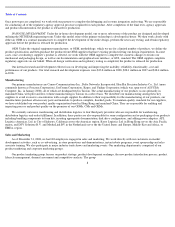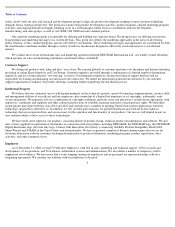Netgear 2008 Annual Report Download - page 20
Download and view the complete annual report
Please find page 20 of the 2008 Netgear annual report below. You can navigate through the pages in the report by either clicking on the pages listed below, or by using the keyword search tool below to find specific information within the annual report.
Table of Contents
priced in foreign currencies which could lose value over time in the event of adverse changes in foreign exchange rates. Even if we are selected
as a supplier, typically a service provider will also designate a second source supplier, which over time will reduce the aggregate orders that we
receive from that service provider. If we were to lose a service provider customer for any reason, we may experience a material and immediate
reduction in forecasted revenue that may cause us to be below our net revenue and operating margin guidance for a particular period of time and
therefore adversely affect our stock price. In addition, service providers may choose to prioritize the implementation of other technologies or the
roll out of other services than home networking. Weakness in orders from this industry could have a material adverse effect on our business,
operating results, and financial condition. We have seen a slowdown in capital expenditures by certain of our service provider customers,
and believe there may be potential for a broader slowdown in the global service provider market in the next few quarters. Any slowdown in the
general economy, over capacity, consolidation among service providers, regulatory developments and constraint on capital expenditures could
result in reduced demand from service providers and therefore adversely affect our sales to them. If we do not successfully overcome these
challenges, we will not be able to profitably grow our service provider sales channel and our growth will be slowed.
We obtain several key components from limited or sole sources, and if these sources fail to satisfy our supply requirements, we may lose
sales and experience increased component costs.
Any shortage or delay in the supply of key product components would harm our ability to meet scheduled product deliveries. Many of the
semiconductors used in our products are specifically designed for use in our products and are obtained from sole source suppliers on a purchase
order basis. In addition, some components that are used in all our products are obtained from limited sources. These components include
connector jacks, plastic casings and physical layer transceivers. We also obtain switching fabric semiconductors, which are used in our Ethernet
switches and Internet gateway products, and wireless local area network chipsets, which are used in all of our wireless products, from a limited
number of suppliers. Semiconductor suppliers have experienced and continue to experience component shortages themselves, such as with
substrates used in manufacturing chipsets, which in turn adversely impact our ability to procure semiconductors from them. Our third party
manufacturers generally purchase these components on our behalf on a purchase order basis, and we do not have any contractual commitments
or guaranteed supply arrangements with our suppliers. If demand for a specific component increases, we may not be able to obtain an adequate
number of that component in a timely manner. In addition, if our suppliers experience financial or other difficulties or if worldwide demand for
the components they provide increases significantly, the availability of these components could be limited. It could be difficult, costly and time
consuming to obtain alternative sources for these components, or to change product designs to make use of alternative components. In addition,
difficulties in transitioning from an existing supplier to a new supplier could create delays in component availability that would have a
significant impact on our ability to fulfill orders for our products. If we are unable to obtain a sufficient supply of components, or if we
experience any interruption in the supply of components, our product shipments could be reduced or delayed. This would affect our ability to
meet scheduled product deliveries, damage our brand and reputation in the market, and cause us to lose market share.
As part of growing our business, we have made and expect to continue to make acquisitions. If we fail to successfully select, execute or
integrate our acquisitions, or if stock market analysts or our stockholders do not support the acquisitions that we choose to execute, then
our business and operating results could be harmed and our stock price could decline.
From time to time, we will undertake acquisitions to add new product lines and technologies, gain new sales channels or enter into new
sales territories. Acquisitions involve numerous risks and challenges, including but not limited to the following:
18
•
integrating the companies, assets, systems, products, sales channels and personnel that we acquire;
•
growing or maintaining revenues to justify the purchase price and the increased expenses associated with acquisitions;
























